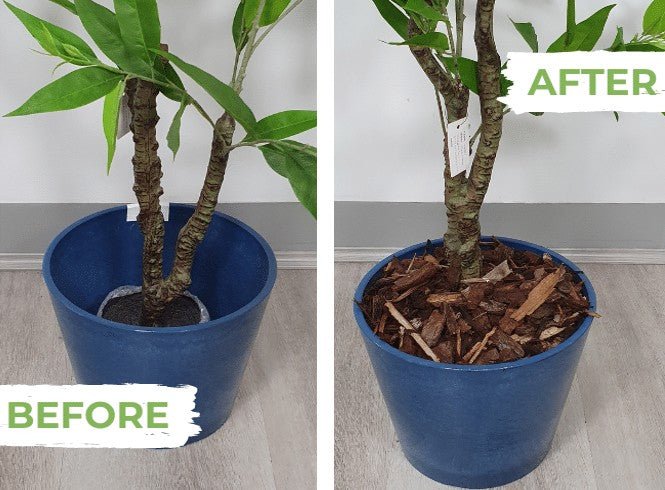A while ago, people buying artificial plants used to think they were stuck with what they got.
Repotting or customizing faux plants wasn’t in the cards for many people, not because it wasn’t possible, but because many didn’t know how.
Yet, with the plethora of options available, there’s not much you can’t do. And since a hanging basket or a planter is only as charming as the plant it holds, the foliage should always be the center of attention.
The wrong pot can dim your statement piece before it’s had the chance to shine. But since the pots you get with artificial plants are simplistic, you’ll need to repot to get to the magic.
If you want to learn how to fix an artificial plant in a pot, keep reading. And if you’re looking to plant your fauxliege into the ground, head to this blog.
Can You Pot Artificial Plants?
Yes, you can pot artificial plants, and it’s easier than you think.
If you’re thinking of buying from our collection, the only faux plants you can pot are artificial topiaries and fake hanging garlands and stems. Soon enough, we’ll add a few more products to the mix so you’ll get even more options.
One of the biggest decisions you’ll have to make is choosing the right pot size and material.
So, what size pot for artificial plants is the best choice?
A general rule of thumb is to get a pot that’s about 2-4 inches larger than the starter pot your artificial plant came with. If you can’t find the pot size on the product page, contact the manufacturer directly and get the details before buying.
In any case, adding more inches in diameter gives your plant more stability, especially if it’s larger and heavier.
Should You Buy an Artificial Plant a New Pot?
You can, but you don’t have to.
Artificial plants normally arrive in starter pots. These are simple and plain pots designed with one purpose in mind: to hold your plant together and provide a weighted base.
While these pots are not ugly, they’re not exciting to look at either, and most clients repot before displaying their plants.
Having a starter pot is great because the aesthetic appearance of your fauxliege will be up to you. You’re free to choose a pot style that fits your space and fill it up exactly as you like it. For this reason, we recommend repotting.
Depending on the type of artificial plant, you’ll need to tweak your choice of pot. For artificial topiary, you’ll want something sturdy, like a heavy ceramic or stone planter that works exceptionally well outdoors.
On the other hand, for hanging artificial plants, you can get a hanging basket or a windowsill planter that’s smaller and lighter to allow the trailing vines to steal the show.
How to Pot Artificial Plants
As we get into the meat and potatoes, it’s time for a short-and-sweet follow-along guide to pot your artificial plants.
But before that, you need to get your tools in order.
What Tools Do You Need?
You’ll need the following tools to repot your artificial plant:
- Your chosen pot
- Filler material (of your choice)
- Potting material (of your choice)
- A large piece of cardboard
- Scissors or a scalpel
- A ruler
- A marker
- A pen knife
Step-By-Step Potting Guide
It’s time to give your artificial plants a fresh, stylish home with the right potting technique. Strap in and take notes.
- Pick the pot: Browse a few stores that sell plant pots and choose your style. Don’t forget to measure the size to ensure it’s larger than the starter pot.
-
Gather your tools: Have the tools by your side to cut time spent rummaging around for missing equipment.

-
Outline and cut: Place your pot on the large piece of cardboard and trace the bottom with a marker. Then, cut out the traced shape and make sure it’s smaller than the outline.

-
Measure and mark: Take your ruler and measure the width of the artificial plant’s base. Then, draw a hole in the cardboard cutout and add a line that divides it in half.

-
Add the filling material: Place the faux plant with its starter pot inside the new pot. Fill the gaps with cardboard scraps or other materials. Then, put the cardboard cover cutout on top to hide the filler.

- Add the potting material: Top off the pot with your chosen potting material and place your faux plant wherever you want it.
What to Fill Fake Plant Pots With?
And now for the fun part - choosing the right filler for your fake plant pots to make them look more real. Here are some of your options:
- Natural elements: If you don’t mind a little upkeep, you may benefit from potting material plucked from nature itself. Twigs, dried leaves, pine cones, or even soil will give your artificial plant that “just planted” look in a minute. While this choice is best realism-wise, these materials may attract pests and insects. Plus, they may need replacing every so often.
- Sustainable materials: To offset your carbon footprint by a bit, you can lean into eco-friendly fillers like recycled glass beads, cork, or shredded paper. These materials are more unconventional, but they’ll add the needed volume and structure to your artificial plant without looking out of place. Plus, they’ll easily hide the cardboard underneath.
- Seasonal accents: Since artificial plants stay vibrant throughout the year, you may decide to swap out the potting material with the turn of the seasons. For example, dried leaves will look right at home during the fall, while berries and cinnamon sticks can help you move toward winter (and smell nice on the way). You can even get playful for the holidays and fill your pots thematically.
- Low-maintenance filler: Lastly, an approach we often recommend to new fake plant parents: a set-it-and-forget-it solution that doesn’t eat up free time. Think pebbles, sand, wood chips, moss, and styrofoam. Pebbles and sand can hold your plant in place and be customized to match any aesthetic. Foam, wood chips, and moss are budget-friendly options that also do the job well.
Finishing Thoughts
We hope this guide has helped you find the right potting technique and material for your new artificial plant.
Now, you’ve got the tools to make your greenery a star. This also makes it a great time to experiment and play around with textures to create something you love.
Since your plants won’t die anytime soon (or ever), you can try different approaches as often as you like. And honestly, that’s the true benefit of artificial greenery.
If you’ve got questions or need advice about planting or potting, reach out to our team here - we’d be happy to help.

